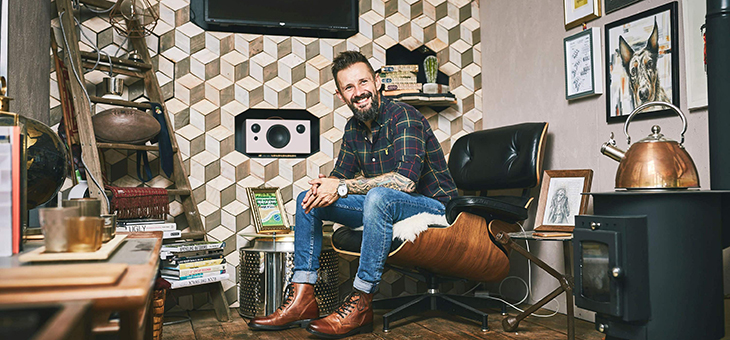Upcycling describes turning unwanted, low-value goods into something more useful or of higher value.
The term is credited to a German engineer named Reiner Pilz, who in the early 1990s began referring to recycling as “down-cycling” because it involved the destruction of what is often perfectly good material. As an alternative, he saw the possibility of giving old products greater value and a new life.
“I really believe that waste can be beautifully upcycled,” says Max McMurdo, eco-designer and TV presenter. “Just because an item can no longer fulfil its original purpose, doesn’t mean it can’t work really well as something else.
View this post on Instagram
“I started upcycling 18 years ago and people didn’t understand what I was doing – they thought I was a mad hippy!” Mr McMurdo lives in a 15-metre upcycled shipping container, which he converted into a floating home – and admits it’s the most ambitious thing he’s ever upcycled.
View this post on Instagram
“It’s fantastic and I love it. I had the bright idea that if I’m telling people what to do, I must do it on the biggest scale of all and upcycle a home. My lampshades are old jelly moulds and my table’s a washing machine drum.”
If you take a look on Pinterest, it seems a lot of people stick to one material (which they’re comfortable with) when upcycling. But for Mr McMurdo, successful product design and upcycling is all about mixing materials, such as wood and glass or metal and leather. “So, with something like a wash drum table, I put a light bulb inside that streams out of the holes, with a piece of glass on top.”
Working with reclaimed materials takes creativity and a little bit of effort. But as Mr McMurdo points out, just because you’re upcycling, it doesn’t mean it should be any less beautiful in terms of design and aesthetic. “You’ll be amazed at how many things you can reuse in a really cool way!”
Mr McMurdo has partnered with Heinz for their ‘Handmade with Heinz’ campaign, which aims to inspire people to upcycle household items and waste – like used tins, for example.
Upcycling should be about buying less and using creativity to rework the resources you already have.
Here are a few ideas to get a foot on the crafting ladder.
1. Upcycle old pallets into cool garden furniture
What you’ll need: some used wood pallets, castor wheels (available in sets of four), selection of ready-made cushions.
Steps: pick up some free wood pallets from a local shop, farm or industrial estate – don’t be afraid to ask! Screw castor wheels to each corner of the bottoms of the pallets to make them manoeuvrable (they come with holes and are easy to affix). Double stack the pallets for the right height. Sand the pallets down lightly to avoid splinters, then wax to seal and make them weather resistant. Add some cushions.
Tip: seal your pallets from bad weather with a furniture stain containing added wood protection to keep them looking nicer for longer.
2. Upcycle a wooden ladder into a cool shelf
What you’ll need: an old wooden ladder, some knick-knacks and anything you want to hang on it.
Steps: find an old wood ladder – the more paint-spattered the better. If you don’t have one, ask neighbours and friends. Prop it securely against a wall and use as a quirky shelf. You can hang it with anything you like, including clip-on lights or fairy lights. This also works as a towel rack in bathrooms.
Tip: this one works especially well for rental properties, as you don’t need to attach anything to walls.
3. Upcycle some old books into a knife block
What you’ll need: four to five old books (buy these from a charity shop if you don’t have any at home), strong string.
Steps: prop your old books upright, next to each other. Wind an old piece of strong string around the books a couple of times and tie it tightly. Pop your knives in it and place on your kitchen top.
Tip: you can also create some great artwork with old books, by folding the pages into a certain pattern, or into words like ‘love’ and ‘home’.
Wondering where to start?
The upcycling mentality can apply on all scales, from buying clothing at an op shop to using crushed brick instead of new concrete in garden paths, right up to designing a house around second-hand materials or, if you’re getting a house demolished, employing a company that deconstructs, rather than wrecks, the building.
Get online and look at some of the projects on Pinterest and YouTube, or take a day trip out to visit a local artist who is being creative with ‘junk’.
If that doesn’t inspire you, then consider getting some skills first — maybe take a sewing class that teaches pattern making so you can make a copy of your favourite dress/shirt, or some basic carpentry, or a course aimed specifically at refurbishing furniture.
Are you a craft lover? Do you already upcycle? What’s your favourite of the projects you’ve completed?
– With PA
If you enjoy our content, don’t keep it to yourself. Share our free eNews with your friends and encourage them to sign up.
Related articles:
https://www.yourlifechoices.com.au/finance/seniors-finance/diy-home-makeover-on-a-budget
https://www.yourlifechoices.com.au/lifestyle/stylewatch/diy-hair-styling
https://www.yourlifechoices.com.au/lifestyle/stylewatch/beauty-experts-skincare-steps

